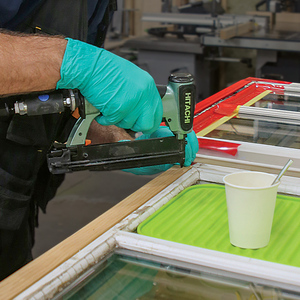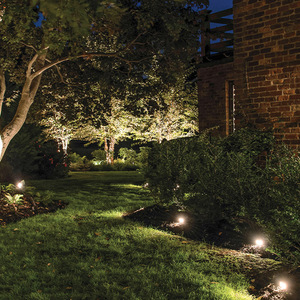Greetings All,
I’m new here and would like to pose a question to the hardwood floor experts. I’ve just finished the installation of my first hardwood flooor and am evaluting the job, looking for ways to improve on the next floor that I install.
The floor is 1 1/2″ clear red oak. I think its going to be beautiful, very tight, hard to see where one board stops and another one starts. I’m going to call in a pro to finish it because I don’t want to mess it up!
I did the install using a Bostitch Mark III stapler which worked great out in the field, drawing the boards together very tightly. However, when approaching the opposite wall, I ran out of space with at least 6 or 8 strips left to go. I was able to squeeze in another course or so by blind nailing with my 15 ga finish nailer. I then began drilling pilot holes and blind nailing with 10d finish nails and my senco palm nailer. This was good for another course or two. I used a small jacking tool to squeeze the boards tight before nailing.
I finished up by drilling slightly angled pilot holes and face nailing the last three courses with 10d finish nails using the palm nailer. Hammer and nail set to finish off. This was an extremely slow and difficult process. The palm nailer tends to bend the nails and there were many that I had to carefully pull out and try again. Occasionally, I’d let the nail set slip, leaving a larger hole to fill.
All the reading, web sites, etc., that I’ve looked at seem to indicate that folks just start using the 15ga finish nailer when they are no longer able to use the blind nailer. If I did this, I’d have two problems – first, I’d be face nailing the last 6 or 8 boards and second, I found that when face nailing, the 15 ga won’t hold the boards as tight as I’d like. That’s why I switched to the palm nailer and the larger finish nails. I was careful to hit the floor joists when face nailing and put another nail between the joists, giving a 8″ nail spacing.
Maybe the narrow strips are a factor. I don’t see much discussion of putting down 1 1/2 strip flooring. Most everything seems to be 2 1/4 and wider. I used the narrow strips to match the new kitchen with the existing floors in the rest of the house.
Thanks for staying with me if you’ve read this far!! I’m anxiously awaiting comments from those who have been there and done this. Hopefully there are better ways ways to handle this.
John



















Replies
While hardwood floors aren't my specialty, I installed several last year. Never anything as narrow as 1 1/2", I think is what you stated. On every floor, the last several runs were face nailed using a 15ga nailer. They will move slightly, and that always bothers me as well. As for the nail holes, by the time you sand and finish, if they are still noticeable, which they will be, you can add a putty that matches your finished product. From my experience puttying before finishing makes it look worse. I too, am anxious to see what the pros have to say.
sounds like you did it well enough, it's pretty much impossible to avoid some face nailing... that's what filler is for :)
the perimeter isn't going to get any foot traffic anyways, so you don't need to overly worry about the boards wiggling loose. Did you T&G the strips?
Yes, these are 1 1/2" T&G strips. Point well taken on the lack of foot traffic on the perimeter.
I'm a bit of a perfectionist - guess I just want the last few boards to be as tight and smooth as the rest of the floor. Except for a piece or two here and there, I've managed to keep the face-nailed parts tight - Just wish there were a way to speed up the process - working up against the wall with palm nailer, hammer and nail set is no fun and slow.
Powernail (http://www.powernail.com) makes a number of different manual and pneumatic face nailers - wonder if those barbed cleats would hold the boards tighter than the 15ga finish nailer? Sure would be a lot faster.
what i did on my hardwood floor was just use the finish nailer and i was also worried they weren't as tight but my professional finisher used a filler over the entire floor not just to fill the holes and cracks but also as a kind of gauge for the sanding process. as he sanded and the filler color disappeared he was able to tell that he had sanded more or less evenly. also he said i was entirely to fussy with the entire installation, it was nice and tight, but not neccesary to be so meticulous. it has been my experience that amateurs (or those with somewhat less experience) tend to overbuild. usually no harm in that but according to an article in fine homebuilding by an expert on the east coast ( i forget the name of installer and issue in which it appeared) you have to leave 1/2 inch at edge of hardwood floor for expansion and contraction. so if it is going to expand and contract fussing over boards not being quite as tight at edge and eliminating even the slightest cracks in the field is a moot point
we just finished three floors (cherry - walnut - oak - random 2", 3", 4") - and rented the manual nailer kit that use the flat, barbed nails - the kit had the angle tool and also the straight nailer - certainly we dealt with the same challenge you talk about - did what was necessary to draw the boards tight, and bam one thru the face, two if there was any wang, and no, they don't cramp it as tight as the angled nailer, but we are satisfied with the job - it's gotta be better than the finish nailer - no drilling or fussing -
Not a direct response to your question but I would not worry about it. Your boards are tight today. Tomorrow it will be different depending on where you live. Oak (plain sawn) moves a lot with the humidity. Quarter sawn moves less, but still moves. If You installed it tight and left a 1/2" - 3/4" expansion space at the edges you should not have a problem. If you live where there are 4 seasons there will be gaps between the board during the heating season and no gaps during the summer (unless you did not leave an expansion space, then you will have ridges from the buckled boards).
I nailed down 7000 sf of 1 1/2 Common and better Red Oak last year. It can be a tough one to put down. It was not exactly straight. But we beat it into place. You handle the wood or it handles you. You make the choice. I choose to be the boss. As for the edges. They should look the same as the field. I use a long fat screwdriver to drive into the plywood next to the tongue and pull it back into the floor. Then I hold that pressure while I hit the face of the board with a hammer to make sure it is in place. Once that is done, I face nail it near the screwdriver in the grain of the board if there is any to hide the nail when finished. The key is to hold that screwdriver pressure while you nail. We hit the board with the hammer because the boards tend to climb up the screwdriver when pressured. EVERY face nail requires this procedure if you want tight fitting edges. Floors tend to shrink over time so I don't want to start off with a gapped floor, filler or no filler and I choose the later. GW
Greg,
What type of nailer did you use for face nailing? I had no problem getting the boards pulled up tight, but after face nailing with my 15ga finish nailer, a small gap would open up when I took the pressure off. That's why I switched to hand-nailing with heavier nails.
John
When you get to a point where floor nailer will no longer work start nailing the tongues, I can usually get all but the last 2-3 rows before having to face nail. Use two wood wedges to drive against each other, either screw first wedge down and drive 2nd to tighten joints or use sill plate as ancorehing point, works for me.
The Powernail facenailer does indeed work great and it leaves a rectangular hole which blends well with oak grain better than the round finish nail holes. It's also really fast.
carpenter in transition
i like to put a 1x4 scrap against the wall, spanning a couple of studs, and use a super wonder bar to squeeze the the last couple of boards into place.
i also like to face nail the boards on the dark grain and that helps them disappear in the finishing.
good luck rg
Great input, guys - thanks to everyone who took time to respond. Here's the jacking tool that I used to pull the boards up tight:
http://www.powernail.com/model100.htm
Expensive, but very well made. Once you get the boards pulled together, this thing has a ratcheting mechanism that will hold the boards tight, leaving your hands free to nail.
Next time out, I'm gonna try nailing through the tounge as one of the posters suggested. This should get it doen to maybe two boards that need to be face nailed - with any luck, maybe the base and shoe molding will cover the nail holes in the last run.
John
Our old floors are all 1 1/2" oak. One thing to consider when you have to go to face nailing is that ordinary steel nails over the long term will cause black stains around them. Tiny amounts of water from years of cleaning are all that it takes. For the very best of excellence, try going with stainless. To prevent bending nails with the palm nailer, try grabbing the middle of the nail tightly with channel locks as you drive it.
-- J.S.